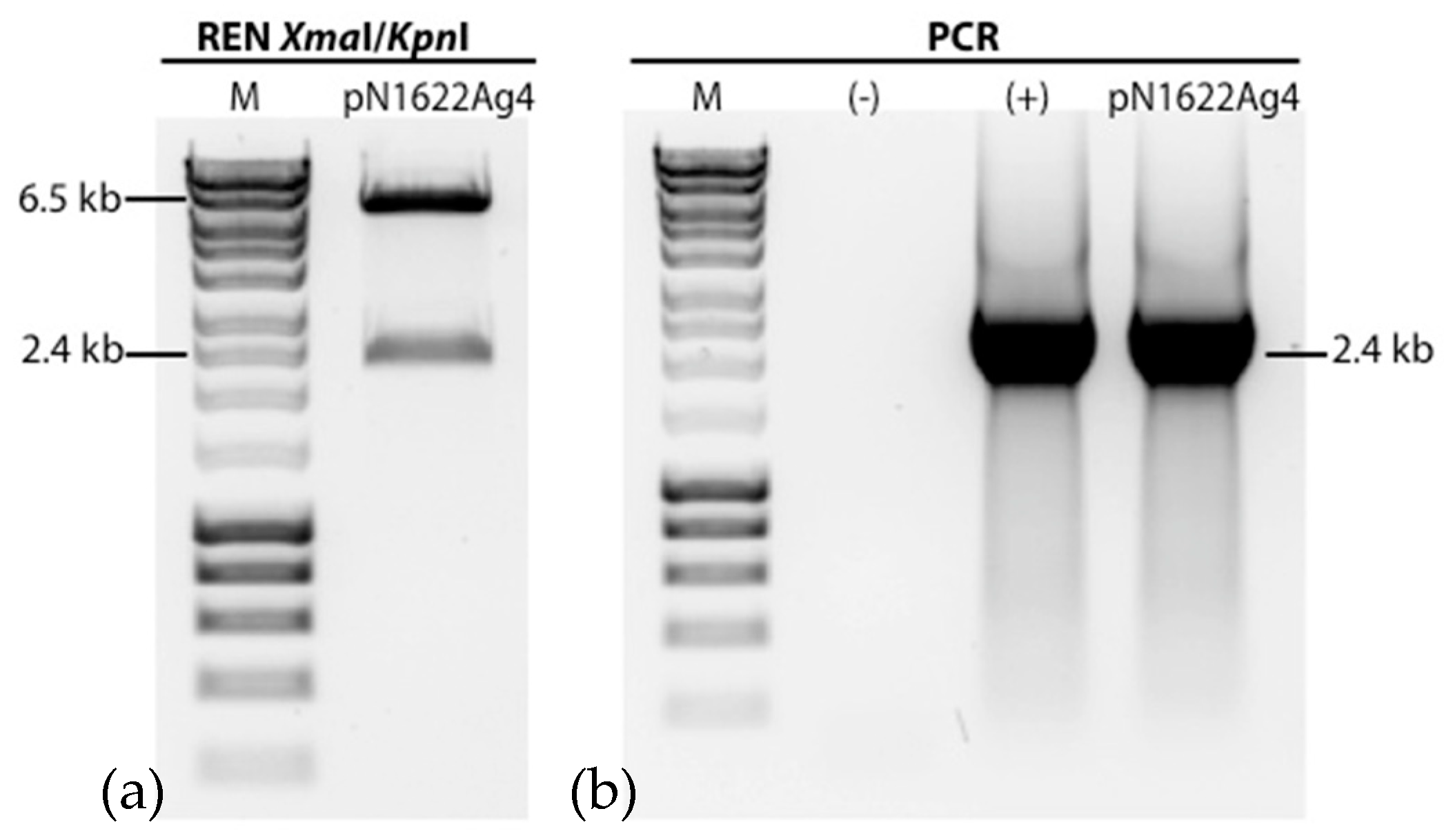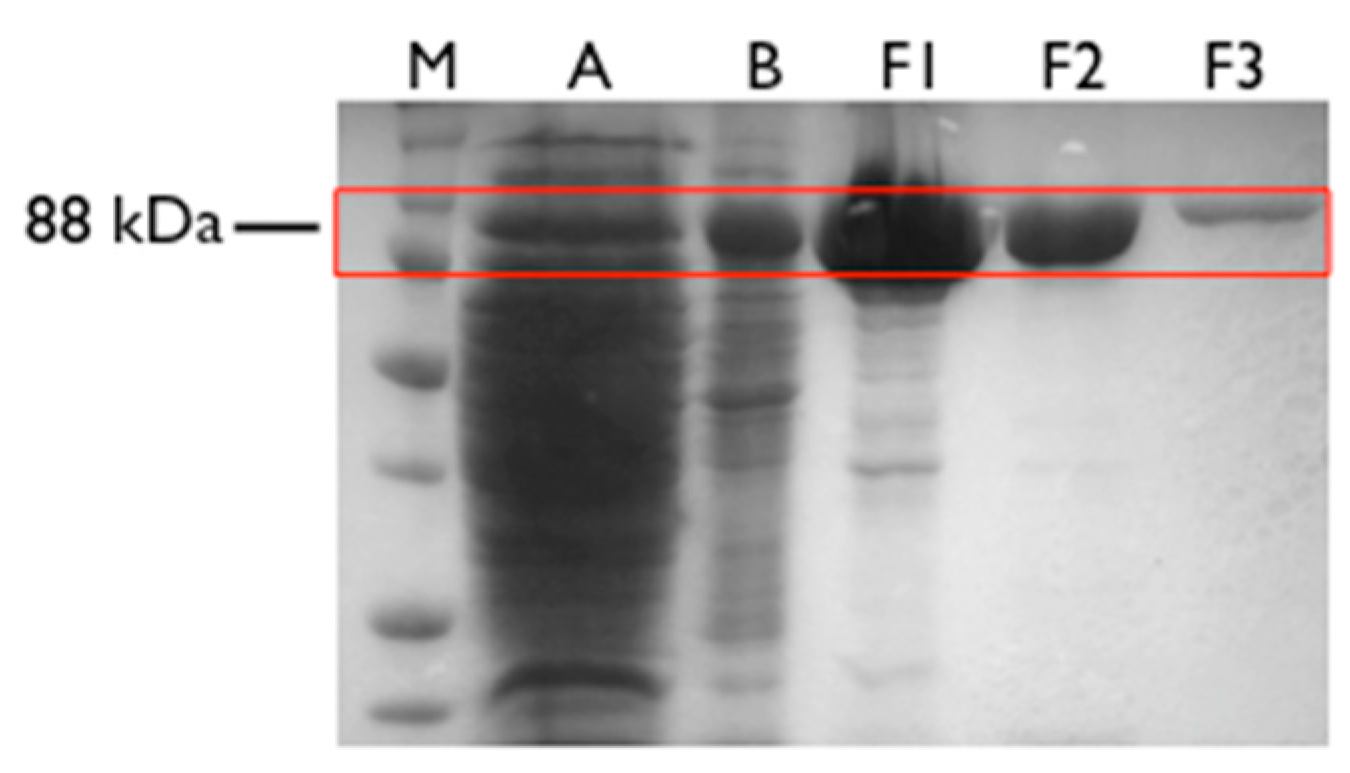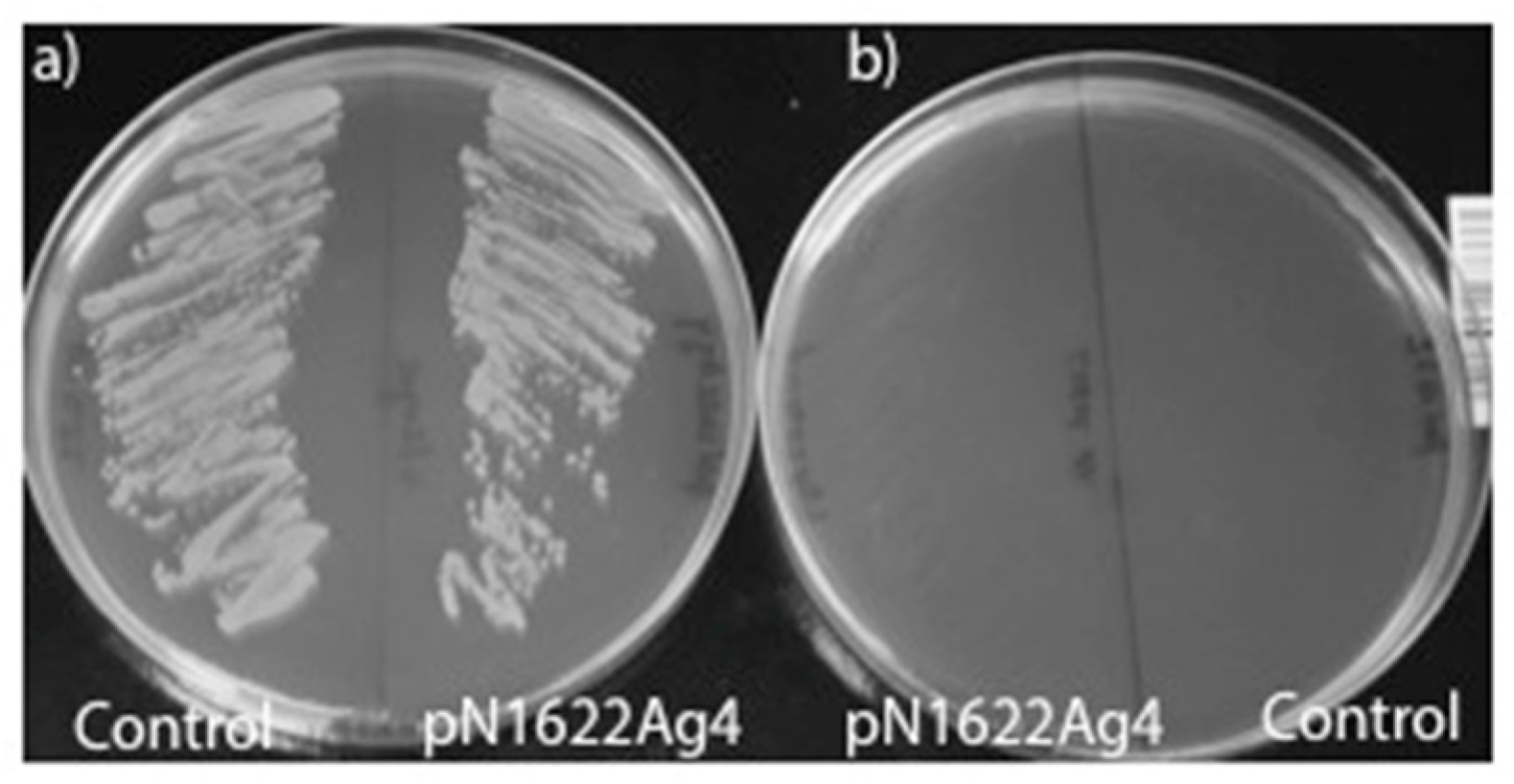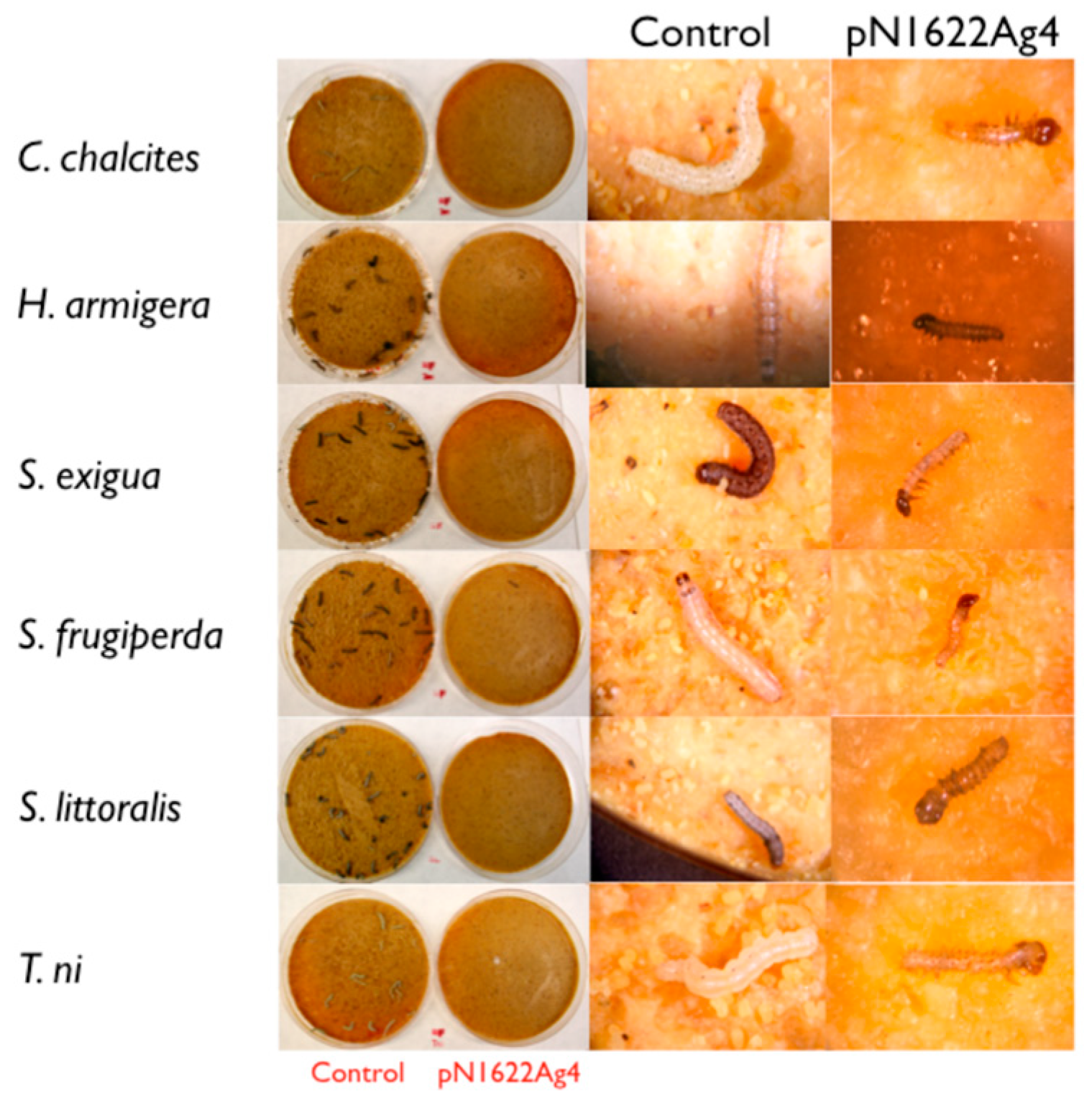Insecticidal Activity of Microencapsulated Vip3Ag4 protein in Bacillus megaterium †
Abstract
:1. Introduction
2. Materials and Methods
2.1. Bacterial Strains and Growth Conditions
2.2. Amplification and Cloning of vip3Ag4 Gene
2.3. Amplification and Cloning of vip3Ag4 Gene
2.4. Cell Fixation and Counting
2.5. Preliminary Insect Bioassays Using Microencapsulated Vip3Ag4 Protein
3. Results
3.1. Vip3Ag4 Insecticidal Gene Cloning in B. Megaterium
3.2. Gene Expression in B. megaterium
3.3. Fixation, Counting and Viability Analysis
3.4. Preliminary Bioassays
4. Discussion
Author Contributions
Funding
Institutional Review Board Statement
Informed Consent Statement
Data Availability Statement
Acknowledgments
Conflicts of Interest
References
- Schnepf, E.; Crickmore, N.; Van Rie, J.; Lereclus, D.; Baum, J.; Feitelson, J.; Zeigler, D.R.; Dean, D.H. Bacillus thuringiensis and its pesticidal crystal proteins. Microbiol. Mol. Biol. Rev. 1998, 62, 775–806. [Google Scholar] [CrossRef]
- Bravo, A.; Likitvivatanavong, S.; Gill, S.S.; Soberon, M. Bacillus thuringiensis: A story of a successful bioinsecticide. Insect. Biochem. Mol. Biol. 2011, 41, 423–431. [Google Scholar] [CrossRef]
- Soberón, M.; López-Díaz, J.A.; Bravo, A. Cyt toxins produced by Bacillus thuringiensis: A protein fold conserved in several pathogenic microorganisms. Peptides 2013, 41, 87–93. [Google Scholar] [CrossRef]
- Roh, J.Y.; Choi, J.Y.; Li, M.S.; Jin, B.R.; Je, Y.H. Bacillus thuringiensis as a specific, safe, and effective tool for insect pest control. J. Microbiol. Biotechnol. 2007, 17, 547–559. [Google Scholar]
- Kumar, S.; Chandra, A.; Pandey, K.C. Bacillus thuringiensis (Bt) transgenic crop: An environment friendly insect-pest management strategy. J. Environ. Biol. 2008, 29, 641–653. [Google Scholar]
- Estruch, J.J.; Warren, G.W.; Mullins, M.A.; Nye, G.J.; Craig, J.A.; Koziel, M.G. Vip3A, a novel Bacillus thuringiensis vegetative insecticidal protein with a wide spectrum of activities against lepidopteran insects. Proc. Natl. Acad. Sci. USA 1996, 93, 5389–5394. [Google Scholar] [CrossRef]
- Warren, G.W.; Koziel, M.G.; Mullins, M.A.; Nye, G.J.; Carr, B.; Desai, N.M.; Kostichka, K.; Duck, N.B.; Estruch, J.J. Auxiliary Proteins for Enhancing the Insecticidal Activity of Pesticidal Proteins. US Patent 5,770,696, 23 June 1998. [Google Scholar]
- Letourneau, D.K.; Hagen, J.A.; Robinson, G.S. Bt-Crops Evaluating Benefits under Cultivation and Risks from Escaped Transgenes in the Wild; CRC Press: Boca Raton, Fla, USA, 2002. [Google Scholar]
- Yin, Y.; Flasinski, S.; Moar, W.; Bowen, D.; Chay, C.; Milligan, J.; Kouadio, J.L.; Pan, A.; Werner, B.; Buckman, K.; et al. A new Bacillus thuringiensis protein for Western corn rootworm control. PLoS ONE 2020, 15, e0242791. [Google Scholar] [CrossRef]
- Kurtz, R.W.; McCaffery, A.; O’Reilly, D. Insect resistance management for Syngenta’s VipCot transgenic cotton. J. Invertebr. Pathol. 2007, 95, 227–230. [Google Scholar] [CrossRef]
- Hernández-Martínez, P.; Khorramnejad, A.; Escriche, A.B. The secret of HD1success: Why it can control effectively S. exigua larvae? In Proceedings of the 54th Annual Meeting of the Society for Invertebrate Pathology (Virtual Meeting), Nelson Mandela Bay, South Africa, 1–4 August 2022. [Google Scholar]
- Thompson, M.; Schwab, G.E. Delta-Endotoxin Expression in Pseudomonas fluorescens. US Patent 5,840,554, 18 June 1996. [Google Scholar]
- Hernández-Rodríguez, C.S.; Ruiz de Escudero, I.; Asensio, A.C.; Ferré, J.; Caballero, P. Encapsulation of the Bacillus thuringiensis secretable toxins Vip3Aa and Cry1Ia in Pseudomonas fluorescens. Biol. Control 2013, 66, 159–165. [Google Scholar] [CrossRef]
- Grace, J.K.; Ewart, D.M. Recombinant cells of Pseudomonas fluorescens: A highly palatable encapsulation for delivery of genetically engineered toxins to subterranean termites (Isoptera: Rhinotermitidae). Lett. Appl. Microbiol. 1996, 23, 183–186. [Google Scholar] [CrossRef]
- Gaertner, F.; Quick, C.; Thompson, M. CellCap: An Encapsulation System for Insecticidal Biotoxin Proteins; Marcel Dekker, Inc.: New York, NY, USA, 1993. [Google Scholar]
- Lampel, J.S.; Canter, G.L.; Dimock, M.B.; Kelly, J.L.; Anderson, J.J.; Uratani, B.B.; Foulke, J.S.; Turner, J.T. Integrative Cloning, Expression, and Stability of the cryIA(c) Gene from Bacillus thuringiensis subsp. kurstaki in a Recombinant Strain of Clavibacter xyli subsp. cynodontis. Appl. Environ. Microbiol. 1994, 60, 501–508. [Google Scholar]
- Bora, R.S.; Murty, M.G.; Shenbagarathai, R.; Sekar, V. Introduction of a lepidopteran-specific insecticidal crystal protein gene of Bacillus thuringiensis subsp. kurstaki by conjugal transfer into a Bacillus megaterium strain that persists in the cotton phyllosphere. Appl. Environ. Microbiol. 1994, 60, 214–222. [Google Scholar]
- Mohammed, Y.; Lee, B.; Kang, Z.; Du, G. Development of a two-step cultivation strategy for the production of vitamin B12 by Bacillus megaterium. Microb. Cell Fact. 2014, 13, 102. [Google Scholar] [CrossRef]
- Biedendieck, R.; Yang, Y.; Deckwer, W.D.; Malten, M.; Jahn, D. Plasmid system for the intracellular production and purification of affinity-tagged proteins in Bacillus megaterium. Biotechnol. Bioeng. 2007, 96, 525–537. [Google Scholar] [CrossRef]
- Korneli, C.; David, F.; Biedendieck, R.; Jahn, D.; Wittmann, C. Getting the big beast to work--systems biotechnology of Bacillus megaterium for novel high-value proteins. J. Biotechnol. 2013, 163, 87–96. [Google Scholar] [CrossRef]
- Vary, P.S.; Biedendieck, R.; Fuerch, T.; Meinhardt, F.; Rohde, M.; Deckwer, W.D.; Jahn, D. Bacillus megaterium—From simple soil bacterium to industrial protein production host. Appl. Microbiol. Biotechnol. 2007, 76, 957–967. [Google Scholar] [CrossRef]
- Ruiz de Escudero, I.; Estela, A.; Porcar, M.; Martínez, C.; Oguiza, J.A.; Escriche, B.; Ferré, J.; Caballero, P. Molecular and insecticidal characterization of a Cry1I protein toxic to insects of the families Noctuidae, Tortricidae, Plutellidae, and Chrysomelidae. Appl. Environ. Microbiol. 2006, 72, 4796–4804. [Google Scholar] [CrossRef]
- Palma, L.; Ruiz de Escudero, I.; Maeztu, M.; Caballero, P.; Muñoz, D. Screening of vip genes from a Spanish Bacillus thuringiensis collection and characterization of two novel Vip3 proteins highly-toxic to five lepidopteran crop pests. Biol. Control 2013, 66, 141–149. [Google Scholar] [CrossRef]
- Bradford, M.M. A rapid and sensitive method for the quantitation of microgram quantities of protein utilizing the principle of protein-dye binding. Anal. Biochem. 1976, 72, 248–254. [Google Scholar] [CrossRef]
- Barnes, A.; Cummings, S. Cellular Encapsulation of Biological Pesticides Produced by Expression of Heterologous Genes. US Patent 4,695,455, 22 September 1987. [Google Scholar]
- Greene, G.L.; Leppla, N.C.; Dickerson, W.A. Velvetbean Caterpillar: A Rearing Procedure and Artificial Medium123. J. Econ. Entomol. 1976, 69, 487–488. [Google Scholar] [CrossRef]
- Ibrahim, M.A.; Griko, N.; Junker, M.; Bulla, L.A. Bacillus thuringiensis: A genomics and proteomics perspective. Bioeng. Bugs 2010, 1, 31–50. [Google Scholar] [CrossRef] [PubMed]
- de Maagd, R. Bacillus thuringiensis-Based Products for Insect Pest Control. In Principles of Plant-Microbe Interactions; Lugtenberg, B., Ed.; Springer: Cham, Switzerland, 2015. [Google Scholar]
- van Frankenhuyzen, K. Cross-order and cross-phylum activity of Bacillus thuringiensis pesticidal proteins. J. Invertebr. Pathol. 2013, 114, 76–85. [Google Scholar] [CrossRef] [PubMed]
- van Frankenhuyzen, K. Insecticidal activity of Bacillus thuringiensis crystal proteins. J. Invertebr. Pathol. 2009, 101, 1–16. [Google Scholar] [CrossRef]
- Sanchis, V. From microbial sprays to insect-resistant transgenic plants: History of the biospesticide Bacillus thuringiensis. A review. Agron. Sustain. Dev. 2011, 31, 217–231. [Google Scholar] [CrossRef]
- Donovan, W.P.; Engleman, J.T.; Donovan, J.C.; Baum, J.A.; Bunkers, G.J.; Chi, D.J.; Clinton, W.P.; English, L.; Heck, G.R.; Ilagan, O.M.; et al. Discovery and characterization of Sip1A: A novel secreted protein from Bacillus thuringiensis with activity against coleopteran larvae. Appl. Microbiol. Biotechnol. 2006, 72, 713–719. [Google Scholar] [CrossRef]
- Qin, Y.; Ying, S.H.; Chen, Y.; Shen, Z.C.; Feng, M.G. Integration of insecticidal protein Vip3Aa1 into Beauveria bassiana enhances fungal virulence to Spodoptera litura larvae by cuticle and per Os infection. Appl. Environ. Microbiol. 2010, 76, 4611–4618. [Google Scholar] [CrossRef]
- Eppinger, M.; Bunk, B.; Johns, M.A.; Edirisinghe, J.N.; Kutumbaka, K.K.; Koenig, S.S.; Creasy, H.H.; Rosovitz, M.J.; Riley, D.R.; Daugherty, S.; et al. Genome sequences of the biotechnologically important Bacillus megaterium strains QM B1551 and DSM319. J. Bacteriol. 2011, 193, 4199–4213. [Google Scholar] [CrossRef]




Disclaimer/Publisher’s Note: The statements, opinions and data contained in all publications are solely those of the individual author(s) and contributor(s) and not of MDPI and/or the editor(s). MDPI and/or the editor(s) disclaim responsibility for any injury to people or property resulting from any ideas, methods, instructions or products referred to in the content. |
© 2023 by the authors. Licensee MDPI, Basel, Switzerland. This article is an open access article distributed under the terms and conditions of the Creative Commons Attribution (CC BY) license (https://creativecommons.org/licenses/by/4.0/).
Share and Cite
Palma, L.; Ruiz de Escudero, I.; Mañeru-Oria, F.; Berry, C.; Caballero, P. Insecticidal Activity of Microencapsulated Vip3Ag4 protein in Bacillus megaterium. Biol. Life Sci. Forum 2023, 24, 9. https://doi.org/10.3390/IECT2023-14822
Palma L, Ruiz de Escudero I, Mañeru-Oria F, Berry C, Caballero P. Insecticidal Activity of Microencapsulated Vip3Ag4 protein in Bacillus megaterium. Biology and Life Sciences Forum. 2023; 24(1):9. https://doi.org/10.3390/IECT2023-14822
Chicago/Turabian StylePalma, Leopoldo, Iñigo Ruiz de Escudero, Francisco Mañeru-Oria, Colin Berry, and Primitivo Caballero. 2023. "Insecticidal Activity of Microencapsulated Vip3Ag4 protein in Bacillus megaterium" Biology and Life Sciences Forum 24, no. 1: 9. https://doi.org/10.3390/IECT2023-14822







